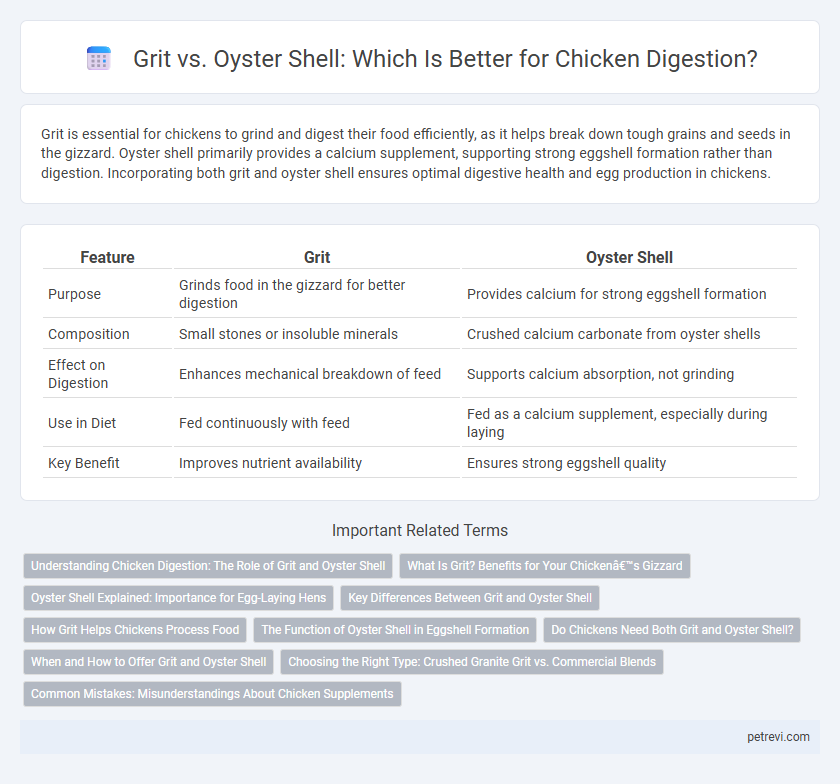Grit is essential for chickens to grind and digest their food efficiently, as it helps break down tough grains and seeds in the gizzard. Oyster shell primarily provides a calcium supplement, supporting strong eggshell formation rather than digestion. Incorporating both grit and oyster shell ensures optimal digestive health and egg production in chickens.
Table of Comparison
| Feature | Grit | Oyster Shell |
|---|---|---|
| Purpose | Grinds food in the gizzard for better digestion | Provides calcium for strong eggshell formation |
| Composition | Small stones or insoluble minerals | Crushed calcium carbonate from oyster shells |
| Effect on Digestion | Enhances mechanical breakdown of feed | Supports calcium absorption, not grinding |
| Use in Diet | Fed continuously with feed | Fed as a calcium supplement, especially during laying |
| Key Benefit | Improves nutrient availability | Ensures strong eggshell quality |
Understanding Chicken Digestion: The Role of Grit and Oyster Shell
Grit and oyster shell serve distinct purposes in chicken digestion, with grit aiding the mechanical breakdown of food in the gizzard and oyster shell providing essential calcium for eggshell formation. Grit consists of small, insoluble stones that chickens consume to grind grains and improve nutrient absorption, while oyster shell is a natural calcium carbonate supplement crucial for strong eggshell production. Proper supplementation of both ensures optimal digestive efficiency and supports overall poultry health and productivity.
What Is Grit? Benefits for Your Chicken’s Gizzard
Grit consists of small, hard particles like sand or crushed stones that chickens ingest to aid their gizzards in grinding food, improving digestion and nutrient absorption. It enhances mechanical breakdown of grains and fibrous materials, supporting efficient digestive processes and overall health. Providing grit helps maintain strong gizzard function, essential for optimal feed conversion and growth in chickens.
Oyster Shell Explained: Importance for Egg-Laying Hens
Oyster shell is a vital calcium source for egg-laying hens, providing essential minerals that support strong eggshell formation and overall bone health. Unlike grit, which aids in grinding food in the gizzard, oyster shell supplements directly enhance calcium intake, crucial during peak egg production. Consistent access to crushed oyster shell helps maintain optimal eggshell quality and prevents calcium deficiency-related issues such as thin or brittle eggshells.
Key Differences Between Grit and Oyster Shell
Grit and oyster shell serve distinct functions in chicken digestion; grit is made of small, coarse particles like granite or flint that chickens consume to grind food in their gizzards, enhancing mechanical digestion. Oyster shell primarily provides a rich source of calcium, essential for strong eggshell formation and bone health in laying hens. While grit aids in breaking down food for nutrient absorption, oyster shell mainly supports reproductive health by supplying the necessary minerals for egg production.
How Grit Helps Chickens Process Food
Grit plays a crucial role in chicken digestion by grinding down food in the gizzard, enabling efficient nutrient absorption. Unlike oyster shell, which primarily provides calcium for eggshell formation, grit consists of small, hard particles that physically break down seeds and grains. This mechanical digestion enhances overall feed utilization and supports the chicken's digestive health.
The Function of Oyster Shell in Eggshell Formation
Oyster shell primarily provides calcium carbonate, a crucial mineral for the formation and strengthening of eggshells in laying hens. While grit aids in mechanical digestion by grinding feed in the gizzard, oyster shell directly supports eggshell quality by supplying essential calcium during shell calcification. Adequate oyster shell supplementation helps prevent eggshell thinning and reduces the incidence of cracked or malformed eggs.
Do Chickens Need Both Grit and Oyster Shell?
Chickens require grit to aid in grinding and digesting food within their gizzards, as it provides the necessary abrasive action. Oyster shell supplies calcium essential for eggshell formation and bone health but does not assist in digestion. Therefore, both grit and oyster shell serve distinct purposes, and providing chickens with access to each ensures optimal digestive function and overall health.
When and How to Offer Grit and Oyster Shell
Offer grit to chickens when they are allowed to forage, as it aids in grinding food within their gizzards for better digestion, typically provided free-choice in a separate container. Oyster shell should be offered to laying hens during their peak egg production periods to supply essential calcium for strong eggshell formation, usually given separately from their regular feed. Both grit and oyster shell must be clean, dry, and replenished regularly to ensure optimal nutrient absorption and overall health.
Choosing the Right Type: Crushed Granite Grit vs. Commercial Blends
Crushed granite grit, composed of durable quartz, enhances mechanical digestion by effectively grinding feed in the gizzard, improving nutrient absorption and overall chicken health. Commercial oyster shell blends, rich in calcium carbonate, primarily support eggshell formation but offer minimal contribution to digestion. Selecting crushed granite grit over oyster shell blends optimizes gastrointestinal function, ensuring better feed efficiency and stronger skeletal development in poultry.
Common Mistakes: Misunderstandings About Chicken Supplements
Many chicken keepers confuse grit and oyster shell, mistakenly using oyster shell as a substitute for grit, which can hinder proper digestion since grit helps grind food in the gizzard. Oyster shell primarily provides calcium essential for eggshell formation, whereas grit physically aids in breaking down feed particles. Overlooking these distinct functions can lead to nutritional imbalances and digestive issues in poultry flocks.
Grit vs Oyster Shell for Chicken Digestion Infographic

 petrevi.com
petrevi.com